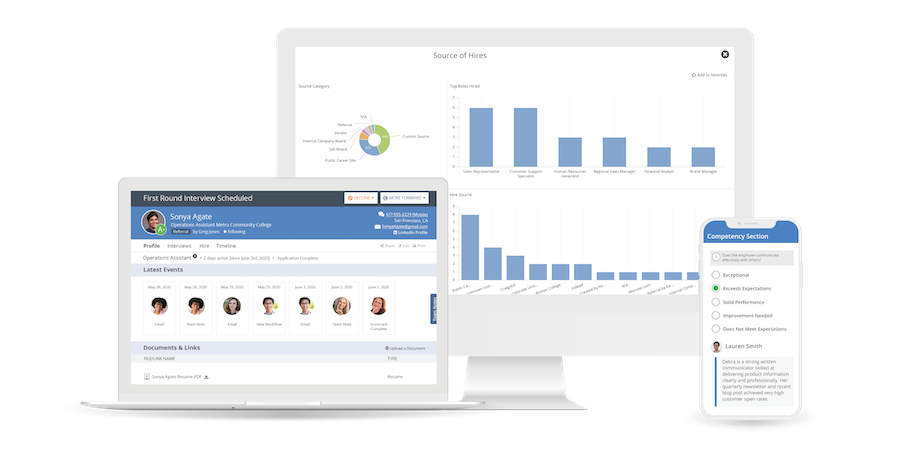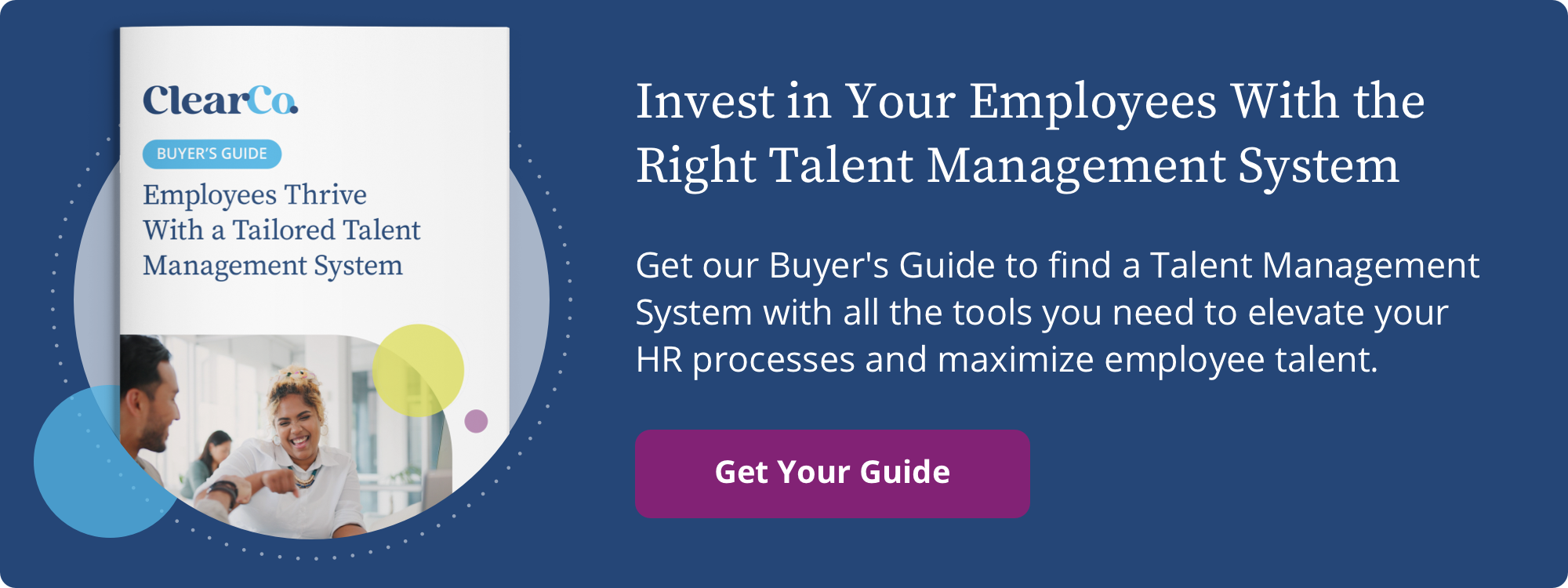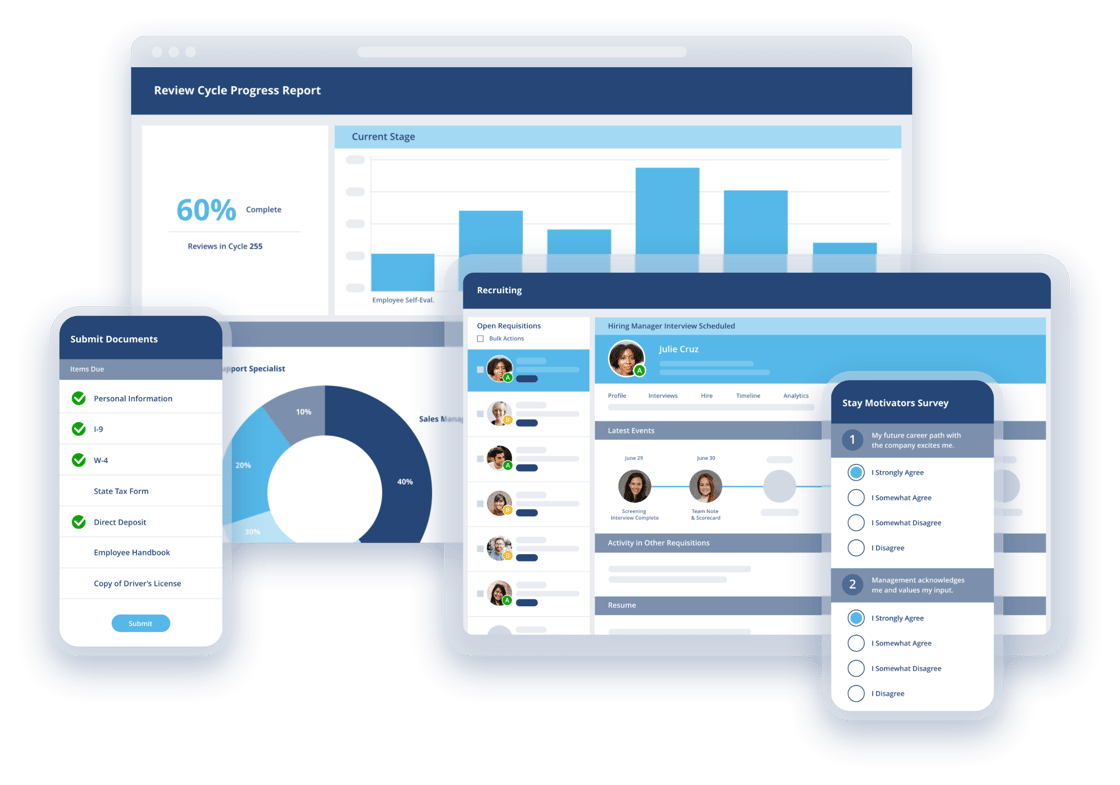This article on employee development statistics was originally published in 2021. All relevant statistics and information have been updated as of August 2023.
A desire for career development opportunities is one of the top reasons workers move to a new company or start their job search. That alone proves that employees desire professional growth and a chance to learn new skills. And, good news — employee development statistics show that supporting your people’s growth pays off.
Investing in employee development creates a more loyal workforce who have the skills your business needs to innovate and evolve. Learning and development opportunities are also a critical part of a successful performance management strategy.
Stay competitive, both as a company and as an employer, when you give your employees opportunities to hone their strengths and learn new skills. Keep reading to see the career development statistics that prove its worth.
Elevating Recruitment and Retention
Did you know that 94% of companies are concerned about their retention rate? Opportunities for employee training and development are one of the main reasons people choose to switch jobs. As such, professional development also plays an important role in attracting candidates and retaining your top talent.
These talent development statistics show just how big of an impact development has on recruitment and employee retention.
1. 76% of employees are looking for opportunities to expand their careers.
2. 86% of employees say they’d switch jobs for one with more chances to grow.
3. Retention is 34% higher among employees who have opportunities for professional development.
4. If a company invests in employees’ careers, 94% said they would stay at the company longer.
5. The youngest generation of employees, ages 18-34, says that upward career mobility and opportunities to learn new skills are top factors when considering a new job.
6. Companies that invested in employee development saw a 58% increase in retention.
It couldn’t be any more clear that professional growth means higher employee retention and draws in new candidates. It only makes sense that employees who feel their growth is being prioritized are more likely to stay at their jobs and talented job seekers would look for roles where they can expect to be promoted and gain new skills.
Giving your employees a variety of ways to learn to shows them you care about their growth and helps you retain ambitious, high-performing employees.
Catalyzing Employee Performance
Learning, development, and formal training are all great ways to help every employee improve their performance and reach their full potential. But lots of employees feel they’re not being given the right tools or opportunities to do their best.
These employee development statistic shows that employees are eager to gain new skills. They also show proof that when you help employees learn, they get better at their jobs.
7. 74% of workers say that a lack of employee development opportunities is preventing them from reaching their full potential.
8. 91% of employees want personalized, relevant training.
9. 55% of employees say they need more training in order to improve.
10. Investing in development led to a 24% productivity increase.
Your workforce wants employee development opportunities — but 74% say a lack of opportunity is holding them back. See more stats on the importance of investing in your employees from @ClearCompany:Entry-level employees are not the only members of your organization who need training and professional development. Managers, department heads, and even executives can continue developing their skills and expanding their expertise throughout their careers. But unfortunately, the statistics show that companies think they’re doing more for their employees’ development than they are.
11. 83% of companies say developing future leaders is important, but…
12. …only 5% have leadership development programs in place.
13. Only 26% of employees say they were challenged to learn a new skill in the past six months.
Training your managers is part of an effective performance management strategy. It helps existing leaders become better leaders and creates new leaders who can advance within your organization —an indicator of a high-performing company.
14. Leadership training increased participants’ capacity for learning by 25% and their performance by 20%.
15. High-impact leadership organizations spend up to three times more on management development than their peers.
With so much of the workforce interested in both leadership and learning, there are undoubtedly future leaders whose skills haven’t been fully realized. Support your existing leaders with training and development so they can be more effective leaders who help their own teams grow.
Fueling Employee Engagement
Employee engagement is one of the HR metrics that tells you a lot about an organization. Engagement leads to better performance, retention, and productivity —everything that contributes to a business meeting its goals. Career development helps build engagement, according to the statistics:
16. Employees who have access to professional development are 15% more engaged.
17. Gallup names development opportunities as one of the five main drivers of employee engagement.
18. 80% of workers say the chance to learn new skills would increase their engagement levels.
To nurture engagement and encourage employees to participate in development initiatives, you need to do more than just present employees with some training courses. As professional development and employee training statistics show, organizations need to take a more intentional, strategic approach.
The key to successfully bridging the gap and providing learning opportunities that your employees will benefit from? Figure out the methods they prefer when it comes to training and development. Using learning strategies that work for your employees makes it much more likely that your efforts will be successful.
19. One-third of employees say ideally they would receive training every three months,
20. while one-quarter prefer monthly training.
21. 70% of employees said online, self-paced courses were their preferred learning method.
22. 62% of workers said hybrid learning, a mix of online and face-to-face, was their desired way to receive training.
Driving Business Success
Career development and training are not only good for your workforce — they’re good for business, too. That’s because when you invest in employee development, your workforce isn’t just gaining new skills, and you’re also creating a company culture of learning. Research finds that organizations with a strong learning culture are:
23. 92% more likely to develop novel products and processes,
24. 52% more productive,
25. 56% more likely to be the first to market with their products and services, and
26. 17% more profitable than their peers.
27. 84% of companies agree that a learning culture leads to a more resilient organization and a better workplace culture.
“I truly believe we as talent leaders will succeed in the long term when we help our businesses orient around skills. When we know the skills our business has or needs, we can upskill our people accordingly. And in so doing, we satisfy both our organizations’ need for agility and our employees’ need for growth and transformation.”
- LinkedIn Chief People Officer Teuila Hanson via LinkedIn
Offering learning, development, and training is a competitive advantage in business for a myriad of other reasons, too. Not least of those is that the organization ends up with knowledgeable, capable employees; employees are more invested in a company that invests in them.
These employee development statistics show that the demand for growth, upskilling, and continued training is high. Employees are more engaged at organizations that prioritize career development, and it’s a powerful tool for recruitment and retention. Career development is what employees and job seekers are looking for, and if you’re the company that provides it, you have a big advantage over other employers.
You can execute performance management strategies designed to maximize your employees’ talent with the help of technology. The right performance management software can make a world of difference in creating a strong, effective employee development program.
With a performance management system, you’ll get access to development tools like:
- Employee-manager one-on-ones, including shared notes and agendas
- Custom performance reviews and expert-informed review templates
- In-depth employee performance data reports and analysis
- Digital employee performance records, including goals, updates, Shout Outs, and more
Get a demo of ClearCompany Performance Management to see these tools in action.






